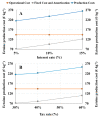Ectoine Production from Biogas in Waste Treatment Facilities: A Techno-Economic and Sensitivity Analysis
- PMID: 34976443
- PMCID: PMC8715504
- DOI: 10.1021/acssuschemeng.1c06772
Ectoine Production from Biogas in Waste Treatment Facilities: A Techno-Economic and Sensitivity Analysis
Abstract
The capacity of haloalkaliphilic methanotrophic bacteria to synthesize ectoine from CH4-biogas represents an opportunity for waste treatment plants to improve their economic revenues and align their processes to the incoming circular economy directives. A techno-economic and sensitivity analysis for the bioconversion of biogas into 10 t ectoine·y-1 was conducted in two stages: (I) bioconversion of CH4 into ectoine in a bubble column bioreactor and (II) ectoine purification via ion exchange chromatography. The techno-economic analysis showed high investment (4.2 M€) and operational costs (1.4 M€·y-1). However, the high margin between the ectoine market value (600-1000 €·kg-1) and the estimated ectoine production costs (214 €·kg-1) resulted in a high profitability for the process, with a net present value evaluated at 20 years (NPV20) of 33.6 M€. The cost sensitivity analysis conducted revealed a great influence of equipment and consumable costs on the ectoine production costs. In contrast to alternative biogas valorization into heat and electricity or into low added-value bioproducts, biogas bioconversion into ectoine exhibited high robustness toward changes in energy, water, transportation, and labor costs. The worst- and best-case scenarios evaluated showed ectoine break-even prices ranging from 158 to 275 €·kg-1, ∼3-6 times lower than the current industrial ectoine market value.
© 2021 The Authors. Published by American Chemical Society.
Conflict of interest statement
The authors declare no competing financial interest.
Figures





Similar articles
-
A systematic comparison of ectoine production from upgraded biogas using Methylomicrobium alcaliphilum and a mixed haloalkaliphilic consortium.Waste Manag. 2020 Feb 1;102:773-781. doi: 10.1016/j.wasman.2019.11.043. Epub 2019 Dec 5. Waste Manag. 2020. PMID: 31812092
-
Ectoines production from biogas in pilot bubble column bioreactors and their subsequent extraction via bio-milking.Water Res. 2023 Oct 15;245:120665. doi: 10.1016/j.watres.2023.120665. Epub 2023 Sep 23. Water Res. 2023. PMID: 37801795
-
Polyhydroxyalkanoates (PHA) production from biogas in waste treatment facilities: Assessing the potential impacts on economy, environment and society.Chemosphere. 2020 Sep;255:126929. doi: 10.1016/j.chemosphere.2020.126929. Epub 2020 Apr 29. Chemosphere. 2020. PMID: 32402877
-
Bioactivity profiling of the extremolyte ectoine as a promising protectant and its heterologous production.3 Biotech. 2022 Dec;12(12):331. doi: 10.1007/s13205-022-03370-5. Epub 2022 Oct 26. 3 Biotech. 2022. PMID: 36311375 Free PMC article. Review.
-
A technical, economic, and environmental analysis of energy production from newspaper in Ireland.Waste Manag. 2007;27(2):177-92. doi: 10.1016/j.wasman.2006.01.003. Epub 2006 Mar 2. Waste Manag. 2007. PMID: 16513338 Review.
Cited by
-
High production of ectoine from methane in genetically engineered Methylomicrobium alcaliphilum 20Z by preventing ectoine degradation.Microb Cell Fact. 2024 May 2;23(1):127. doi: 10.1186/s12934-024-02404-2. Microb Cell Fact. 2024. PMID: 38698430 Free PMC article.
-
Comparative genomic analysis of Halomonas campaniensis wild-type and ultraviolet radiation-mutated strains reveal genomic differences associated with increased ectoine production.Int Microbiol. 2023 Nov;26(4):1009-1020. doi: 10.1007/s10123-023-00356-y. Epub 2023 Apr 17. Int Microbiol. 2023. PMID: 37067733 Free PMC article.
-
MXene: A Roadmap to Sustainable Energy Management, Synthesis Routes, Stabilization, and Economic Assessment.ACS Omega. 2024 Jul 18;9(30):32350-32393. doi: 10.1021/acsomega.4c04849. eCollection 2024 Jul 30. ACS Omega. 2024. PMID: 39100332 Free PMC article. Review.
-
Continuous Valorization of Carbon Dioxide into the Fine Chemical Ectoine by Hydrogenovibrio marinus: A New Strategy for Pharmaceutical Production.Environ Sci Technol. 2025 Mar 18;59(10):5088-5097. doi: 10.1021/acs.est.4c12259. Epub 2025 Mar 4. Environ Sci Technol. 2025. PMID: 40038913 Free PMC article.
References
-
- EBA. Statistical Report of the European Biogas Association 2020. European Biogas Association: Belgium, 2021.
-
- Kaparaju P.; Rintala J.. Generation of heat and power from biogas for stationary applications: boilers, gas engines and turbines, combined heat and power (CHP) plants and fuel cells. In The Biogas Handbook, Science, Production, and Applications; Wellinger A., Murphy J., Baxter D., Eds.; Woodhead Publishing: Cambridge, 2013; pp 404–42710.1533/9780857097415.3.404. - DOI
-
- IRENA. Renewable power generation costs in 2018. International Renewable Energy Agency: Abu Dhabi, 2019; pp 11–30.
-
- IRENA. Renewable power generation costs in 2019. International Renewable Energy Agency; Abu Dhabi, 2020, pp 18–43.
LinkOut - more resources
Full Text Sources
Other Literature Sources
Research Materials
